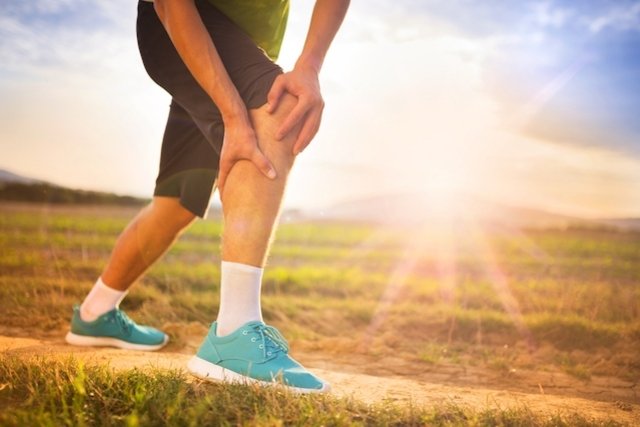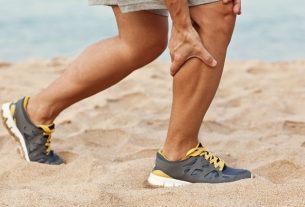Leg cramp is a rapid and voluntary contraction of one of the leg muscles, most commonly occurring in the calf, also called calf, but it can also appear in the muscle on the front or back of the thigh.
Generally, leg cramps can arise due to dehydration, lack of oxygen in the muscle or excess lactic acid due to intense physical exercise or even nutritional deficiencies.
In most cases, leg cramps are not serious and can be relieved with stretching. However, if they are frequent, appear more than once a day or take more than 10 minutes to resolve, it is recommended to consult your general practitioner to identify the cause and begin the most appropriate treatment.

Main causes
The main causes of leg cramps are:
1. Excessive physical exercise
Excessive physical exercise, such as running or lifting heavy weights with your legs in weight training, can lead to muscle fatigue, excess lactic acid and a lack of minerals and oxygen in the muscle, which were consumed during exercise.
Furthermore, dehydration or exercising in very hot climates can increase the risk of leg cramps during physical activity, which can appear during exercise or even a few hours later.
What to do: You should drink plenty of fluids during physical activities, in addition to warming up before and stretching after training, to prepare and recover the muscle, avoiding fatigue and the appearance of leg cramps.
2. Standing still for a long time
Sitting or lying still for a long time in the same position can also cause muscle cramps due to lack of movement.
What to do: You should change position regularly and avoid standing still for a long time. Furthermore, if the person sits for a long time during the day, it is recommended to take short breaks to get up and move their legs.
3. Dehydration
Dehydration can result in less water, minerals and electrolytes in the muscle, and cause leg cramps.
Generally, dehydration occurs due to being in a very hot environment, sweating for a long time or due to the use of diuretic medications, for example.
Other symptoms of dehydration are dry mouth, frequent feeling of thirst, decreased amount of urine and tiredness. Check out the full list of dehydration symptoms.
What to do: You should keep your body hydrated by drinking at least 2 liters of water per day, especially during physical activities and hot days.
4. Nutritional deficiencies
Some nutritional deficiencies, such as a deficiency in vitamins B or D, or minerals such as magnesium, calcium, sodium or potassium, can cause leg cramps, which can appear suddenly, occurring during the day, without an apparent cause.
What to do: You should consult a nutritionist or nutritionist to assess the type of nutritional deficiency, and thus be advised to replace it through supplements and a balanced, nutrient-rich diet.
5. Pregnancy
During pregnancy, especially at the end of pregnancy, it is common to experience cramps in the legs, ankles or feet, especially in the morning. See other symptoms of late pregnancy.
These cramps occur due to the normal hormonal changes during pregnancy and the decrease in blood circulation in the legs due to the compression of the vessels and arteries of the pelvis by the weight of the uterus.
What to do: Gently massage or stretch the calf by moving your feet, pulling the heel down and the toes up, or applying warm compresses to the legs, feet or ankles.
Furthermore, it is important to keep the body hydrated, drinking around 2 liters of water per day, and increase the consumption of foods rich in magnesium and take supplements with calcium, magnesium or vitamin B, as long as they are recommended by the obstetrician.
6. Side effect of medicines
Some medications, such as diuretics for high blood pressure or heart problems, increase the elimination of water and electrolytes from the body, favoring the appearance of cramps in the legs or other muscles.
Furthermore, cramps are a very common side effect of statins, which are cholesterol-lowering drugs.
What to do: the doctor responsible for the treatment should be consulted to reevaluate the medication, and the dose or medicine may be changed. Under no circumstances should treatment be interrupted without medical advice.
7. Liver cirrhosis
Liver cirrhosis is a chronic inflammation of the liver, which can arise due to excessive or frequent consumption of alcoholic beverages, hepatitis B or C, or even fatty liver.
This condition can result in leg cramps, which are usually severe and happen more frequently at night while sleeping.
What to do: Treatment must be carried out under the guidance of a hepatologist and involves changes in diet and the use of medication to control some of the symptoms. In more serious cases, liver transplant surgery may be necessary. Find out how liver cirrhosis is treated.
8. Hypothyroidism
Untreated hypothyroidism can cause muscle changes, such as muscle weakness, especially in the thighs and shoulders, as well as pain or cramps in the leg.
What to do: The treatment recommended by the endocrinologist must be taken, which generally includes levothyroxine to replace thyroid hormones. See how hypothyroidism is treated.
9. Diabetes
Diabetes can also cause leg cramps, which can occur due to electrolyte imbalance, hypoglycemia, peripheral neuropathy, or vascular insufficiency.
Diabetes cramps appear especially in the lower extremities, and are more common to occur during sleep.
What to do: Diabetes treatment must be carried out under the guidance of an endocrinologist, and generally involves changes in diet, physical exercise and/or the use of oral antidiabetic drugs or insulin. See what a diabetes diet should be like.
10. Venous insufficiency
Leg cramps can also be caused by venous insufficiency, as this condition occurs when the valves in the leg veins malfunction, making it difficult for blood to return from the lower limbs to the heart.
This hinders blood circulation in the legs and oxygenation of the muscles, resulting in leg cramps, especially in the calf region.
What to do: Elevating your legs above heart level can help relieve swelling and discomfort. Furthermore, it is important to lose weight and practice physical activity regularly. However, it is important to consult a cardiologist or angiologist in case of suspicion, as the use of compression stockings or even surgery may be indicated. Learn about other causes of cramps.
What to do
To relieve leg cramps, it is recommended that you massage and stretch the contracted muscle.
Thus, when a cramp occurs in the calf, for example, it is recommended to sit on the floor with your leg straight and pull the tip of your foot towards your body, remaining in this position for about 1 minute. Check out other stretching options to relieve cramp pain.
When to go to the doctor
It is important to consult your general practitioner in the following situations:
- Cramp that causes very intense pain and does not improve after 10 minutes;
- Appearance of swelling and redness in the leg;
- Muscle weakness after cramp;
- Cramps that appear often within a few days.
Furthermore, if the cramp is not related to any cause such as dehydration or intense physical exercise, it is also advisable to consult a general practitioner to assess whether there is a lack of any important mineral in the body or whether it is related to a disease.
Make an appointment with a general practitioner in the nearest region:

Sign up for our newsletter and stay up to date with exclusive news
that can transform your routine!
Warning: Undefined array key "title" in /home/storelat/public_html/wp-content/plugins/link-whisper-premium/templates/frontend/related-posts.php on line 12
Warning: Undefined array key "title_tag" in /home/storelat/public_html/wp-content/plugins/link-whisper-premium/templates/frontend/related-posts.php on line 13




